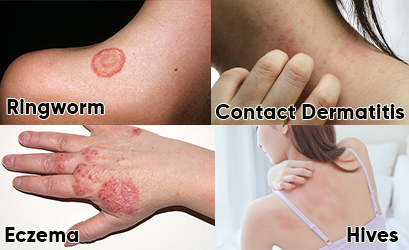
1.Ringworm:
itchy, circular scaly patches with raised borders on lighter skin tones, the patches can appear pink or red on darker skin tones, the patches can appear gray or brown skin in the middle of the ring appears clearer, and the edges of the ring may spread outward.
2.Contact Dermatitis:
Contact dermatitis is a reaction that appears when the skin comes in contact with an irritant or an allergen. Symptoms can include a rash, blisters, itching, and burning.
Soaps, laundry detergents, fabric softeners, shampoos — or even excessive exposure to water — can all cause contact dermatitis. Other items that can cause a reaction are metals (such as nickel, a component of stainless steel and other alloys used to make costume jewelry), adhesives, nail polish, topical medications, plants, and latex gloves.br>
Sometimes an allergen won’t cause a skin reaction unless the skin is also exposed to sunlight. This condition is called photoallergic contact dermatitis. It can occur with products such as shaving lotion, sunscreen, and some perfumes.
3.Eczema:
Eczema, also known as atopic dermatitis, affects between 10 and 20 percent of children and 1 to 3 percent of adults. A common symptom of eczema is dry, red, irritated and itchy skin. Sometimes, especially when infected, the skin may have small, fluid-filled bumps that ooze a clear or yellowish liquid. People with eczema often have a family history of allergies.
4.Hives:
Hives (urticaria) are red bumps or welts that appear on the body. The condition is called acute urticaria if it lasts for no more than six weeks, and chronic urticaria if it persists beyond six weeks. Acute urticaria is most commonly caused by exposure to an allergen or by an infection. The cause of chronic urticaria is largely unknown.